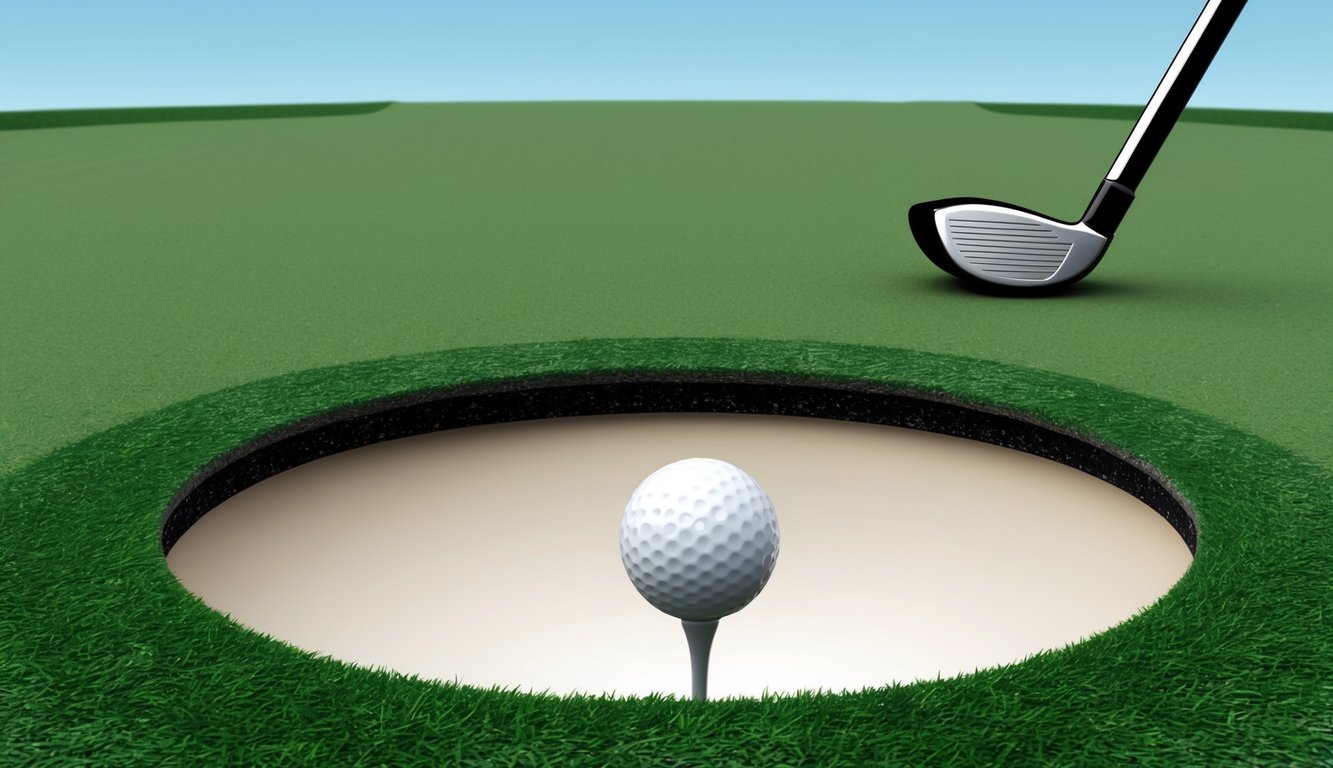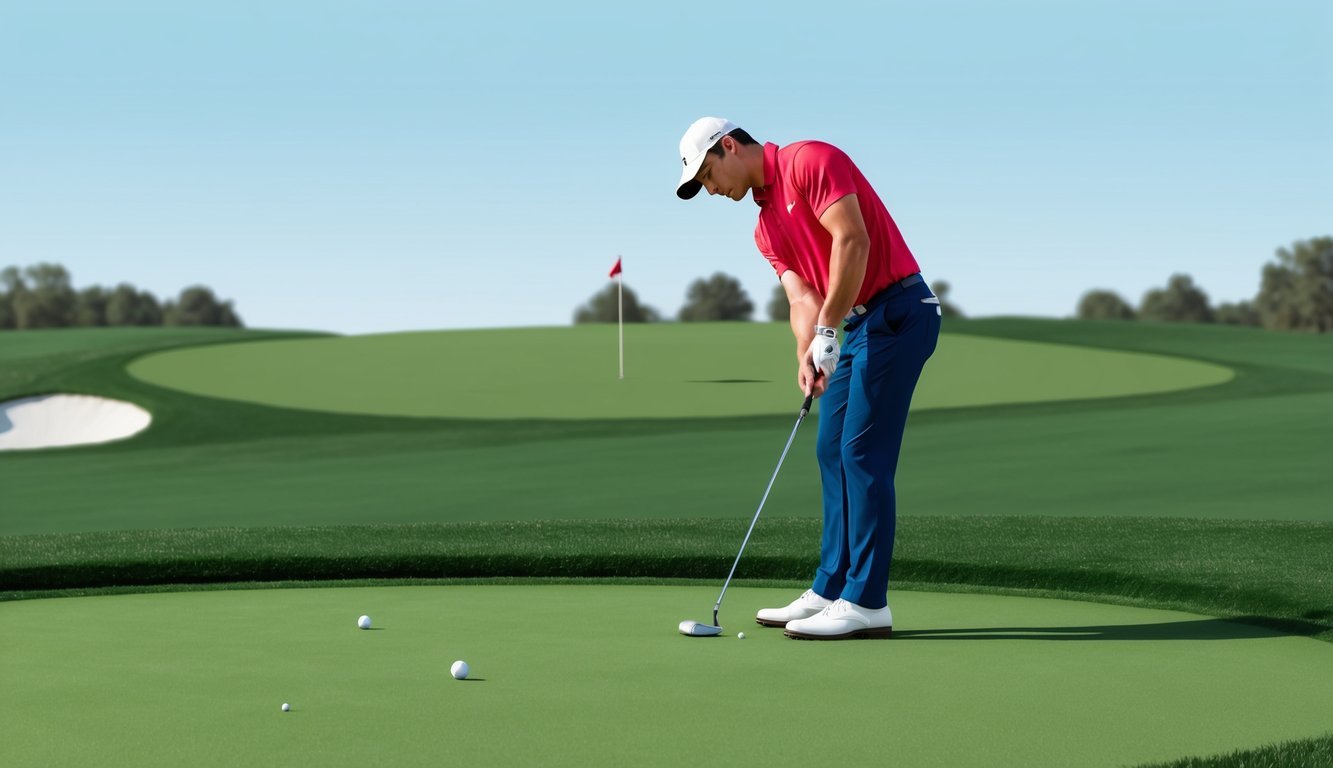Golf can be a challenging game, and mastering the art of the lag putt is crucial for lowering your score.
A lag putt is essentially a long-distance putt aimed at getting the ball close to the hole, reducing the risk of three-putting.
By developing this skill, you can take significant stress off your game and improve your confidence on the greens.

One of the keys to successful lag putting is understanding the distance control and getting a feel for the green’s contours.
Visualization plays a significant role, allowing you to picture the ball’s path and anticipate how it will break.
Regular practice and drills focusing on this aspect can significantly enhance your performance.
To get the most out of your practice sessions, focus on reading the green effectively.
Observing the slope and grass condition will help you aim better and choose the right speed for your putts.
This strategic approach not only sharpens your skills but also offers a satisfying way to see tangible improvements in your golf game.
Key Takeaways
- Understand lag putting to avoid three-putts.
- Use visualization to improve distance control.
- Practice reading greens for better accuracy.
Understanding Lag Putting
Mastering the art of lag putting can significantly improve your golf game by helping you get closer to the hole on longer putts.
This not only enhances your ability to control distance but also lowers the number of three-putts, making your time on the greens more enjoyable and less stressful.
The Concept of Lag Putting
Lag putting is all about getting your ball as close to the hole as possible without necessarily aiming to sink it on the first try.
The primary goal is to set up an easier second putt.
This technique intensely focuses on perfecting your distance control and reading the greens.
Your stance, stroke, and overall technique are critical.
When you’re preparing for a lag putt, it’s essential to consider the break, speed, and undulation of the green.
Understanding how grain affects the ball’s roll can further enhance your ability to lag putts effectively.
Developing a feel for these aspects requires practice and patience.
Key Factors Influencing Lag Putts
Several factors can impact the success of your lag putts.
For instance, the green speed plays a vital role—faster greens require a gentler stroke, while slower greens demand more power.
Ensuring your putter face is correctly aligned with the target is equally important for controlling the trajectory and distance of the ball.
Weather conditions and grass types also affect the roll.
Practicing under various conditions helps develop adaptability.
Moreover, focusing on maintaining a steady rhythm in your stroke can improve consistency.
Familiarizing yourself with these variables can reduce the likelihood of a three-putt and improve your overall experience on the golf course.
Perfecting Your Technique
When working on lag putting, focusing on your stance, grip, and stroke can significantly improve your game.
These elements help in maintaining consistency and accuracy over long distances.
Stance and Grip for Lag Putting
Your stance should be comfortable yet firm to provide stability during the stroke.
Position your feet shoulder-width apart, and slightly bend your knees.
This setup helps maintain balance during your swing.
Your toes should point directly at the target, ensuring proper alignment.
Having the right grip is crucial.
Utilize a putting grip that feels natural.
Many golfers prefer the “reverse overlap” grip, where the left index finger (for right-handed golfers) overlaps the right pinkie.
This grip promotes control and allows for smoother motion, essential for effective lag putting.
The Putting Stroke and Stroke Length
The putting stroke should be smooth and rhythmical.
Focus on using your shoulders to drive the stroke, which helps eliminate unnecessary wrist action.
A longer backstroke is often necessary when dealing with lag putts to cover the required distance.
Stroke length is determined by the distance to the hole.
Practice with alignment sticks to help you judge this correctly.
Place a stick at the target line to improve your aim and ensure your backstroke remains consistent.
Regular practice will help you master both your stroke and stroke length, allowing you to roll the ball closer to the hole with confidence.
Practice Drills and Exercises

Mastering lag putting involves honing specific skills through targeted practice.
You’ll benefit from focusing on drills that improve your control over speed and distance, as well as exercises that enhance your ability to judge these critical aspects.
Lag Putting Drills
Lag putting drills are essential for sharpening your ability to control the ball over long distances.
A popular exercise is the circle drill, where you arrange golf balls in a circle around the hole, each about 3 feet away.
This setup helps you work on achieving a tap-in putt.
Another effective drill is the 30-60-90 drill, where you place balls at varying distances from the hole—30, 60, and 90 feet.
This exercise challenges you to adjust your stroke for different distances, improving your feel and intuition for the green.
Visualization and consistent feedback can enhance these drills, helping you refine your performance.
Speed and Distance Control Exercises
Speed and distance control is crucial in reducing the number of strokes on the green.
Start by practicing uphill and downhill putts, as they require different force and touch.
Focus on maintaining a steady back-and-forth rhythm in your practice strokes to get a feel for each slope.
Incorporate the alignment stick method by placing an alignment stick on the far side of the hole, which helps guide your aim and control.
This exercise forces you to practice missing on the high side, developing your precision in both speed and distance.
Regular feedback from these controlled exercises will better equip you for varied green conditions.
Reading the Green Effectively

Successfully executing a lag putt depends heavily on your ability to interpret the green.
Essential elements include assessing the conditions and understanding factors like break and slope, which influence the ball’s path.
Assessing Green Conditions
Start by understanding the nuances of the green’s surface.
Pay attention to green speed, which affects how fast your ball rolls.
Fast greens mean the ball travels further.
You might find it helpful to use an alignment stick to gauge this and practice on various greens to build familiarity.
Consider grain direction.
This refers to the direction grass grows, which can accelerate or decelerate your putt.
Greens with grain running towards the hole can speed things up.
Always observe the sheen and color of the green.
Darker spots typically indicate grain growing against you, slowing the ball.
Lastly, take note of undulations, as they can influence the path you need to take.
Understanding Break and Slope
Break refers to how the ball curves due to slope.
To read the break accurately, visualize the ball’s path from start to finish.
Stand behind the ball and the hole to get a comprehensive view.
Slopes can be tricky.
Try using your feet to feel changes in elevation, providing insight into the tilt and incline.
Even slight changes can cause significant ball movement.
Practice visualizing the ideal line, adjusting based on the break and slope you perceive.
Use a combination of practice and observation to refine your reading skills, which ultimately leads to more accurate lag putt execution.
Strategies for Lowering Your Score

Boosting your performance on the green is key to improving your overall golf scores.
By focusing on minimizing three-putts and enhancing your opportunities for par and birdie, you can significantly lower your handicap.
Avoiding the Three-Putt
Three-putts can be an obstacle when trying to improve your golf scores.
Consistent practice of lag putting is essential for reducing the risk of encountering these troublesome three-putt scenarios.
Start by practicing drills designed to help you judge the speed and firmness needed for longer putts.
One effective method is setting a tee a foot behind the hole to aim your putts between the hole and the tee, helping to refine your control and accuracy.
For high handicappers, focusing on pace control can be particularly beneficial.
Use drills like the 30-60-90 drill, which involves placing balls at varying distances, to develop a better sense of distance control.
Building confidence with these techniques will lead to more consistent two-putts and reduced scores.
Improving Your Par and Birdie Chances
Maximizing your chances for par and birdie can give your score a significant boost.
To do this, work on your ability to make shorter putts, which are crucial for saving par and achieving birdies.
Practice with a focus on accuracy and developing a steady rhythm in your putting stroke to increase the likelihood of sinking these key putts.
Observing professional golfers, you’ll notice their emphasis on setting up easy putts for par and birdie.
Incorporating drills that simulate game conditions, like varying uphill, downhill, and sidehill putts, helps improve your feel and instinct on the green.
By consistently working on these skills, you’ll improve your potential for lowering your handicap and scoring lower.

